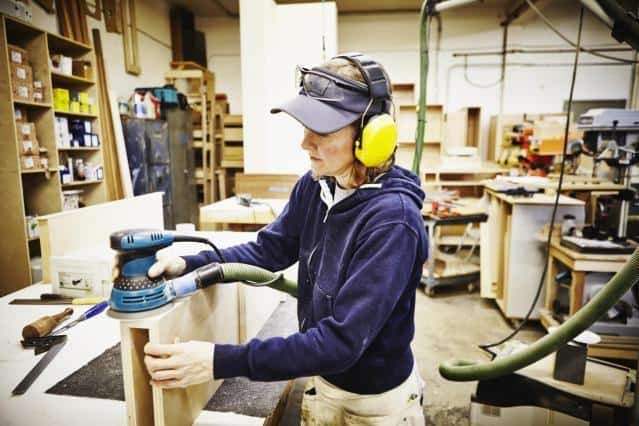Safety Rules For Every Woodworker When Using the Router
Woodworking can be one of the most exciting and enjoyable experiences. However, handling improperly some tools such as a router can have some serious implications. In order to handle woodworking tools safely, you should always adhere to all the rules that come with the user manual. Your workshop should not be a place where you are in a hurry and you should never have the “It will never happen to me” attitude.
Always wear safety gear
The most important woodworking rule is to wear the right safety gear at all times. Always wear hearing protection for some noisy tools such as the router and surface planers. You should also wear latex gloves for the safety of your hands and safety glasses for eye protection. Put on the safety equipment when entering the workshop and do not remove them until you leave the shop. Wear your safety gear, no matter how small the task may be. You should also wear appropriate clothing and avoid anything dangling such as chains, bracelets, and other jewelry.
Avoid any intoxication such as drugs and alcohol
Never mix anything intoxicating with routing. If under influence of anything intoxicating, stay away from the wood shop. It may seem rather harmless and normal for the weekend woodworker to take a beer or two while working on a project. However, you should avoid the temptation until you are done with your project. You are much safer being sober and clean when routing than when intoxicated.
Disconnect the power before changing blades or bits
Whenever you want to change bits or blades ensure the electricity is disconnected. Do not just check if the switch is off but you should ensure it is disconnected since a switch can be turned on accidentally or it may even be non-functional.
Use one extension cord
It is wise to use one heavy-duty extension code for all your tools in your workshop. By doing this you are always forced to switch the cord from one tool to the other before making use of the tool. By so doing, you will always be obliged to plug and unplug the power when switching between tools. You will also be able to disconnect power when changing bits and blades.
Use sharp bits and blades
This may seem obvious but a blunt cutting tool is dangerous. If a tool is not as sharp as it should be, the woodworker and the tool have to work harder in order to finish a task. This may force the tool to kick back or bind. Furthermore, a sharp tool delivers a cleaner cut thus there are more benefits with working with a sharp tool.
Check for nails, screws any other metal in the work piece
This is an obvious precautionary measure that most people overlook. Always check the work piece you are preparing so as to ensure it is free from nails, staples, screws and many other metals prior to cutting. Rapidly spinning bits and blades can cause serious damages when they land on nails or metals. You can even use a metal detector before cutting so as to identify and remove any metals from the stock.

Work against the cutter at all times
Routers and other woodworking tools are designed in a way that the wood moves through the tool in the opposite direction with the cutting head. In simple terms, the bits and the blade cut against the motion. The cutters should always cut into the stock.
Never ever try to remove cut-offs when in operation
Do not put your hand anywhere close to the mowing blade in an effort to remove cut-offs when your router or any other power tool is in operation. You should wait for the tool to stop moving then reach for the cut-offs. It will even be much better if you use a push stick or a piece of scrap to remove the waste after the blade has stopped moving.
Avoid disturbances
We all get distracted from time to time when engaging in everyday tasks and working with your router is no different. In case you are distracted when in the middle of a project, finish the cut before you sort out the distraction. Trying to take away your attention from the woodworking tool poses a major risk to the user.
Ensure the stock is secure
If using the router freehand ensure you clamp the workpiece securely to the bench or work table. You can place a friction mat on top of the bench before you fix the stock in position so as to secure the work and prevent it from shifting.
Chuck the bit properly
Once you have selected the bit you want to use, look out for any damages or visible dullness in the bit and if certain it is in perfect shape, insert it into the collet. Pull the bit out for approximately 1/16 inches since when the bit is left in full contact with collet’s bottom it loosens while routing. You should also avoid over-tightening the collet. Always chuck proper bits in the router.
Use larger bits for router table tasks
Bits that are more than 1 inch in diameter or longer than 1-1/2 should never be used in a freehand router. Bits with larger diameter should have a ½ inch shank and are ideal for a variable speed router and the RPM should be set to suit the diameter of the bit. 1 and 2-inch diameter bits require 18000 RPM, and 2 and 2-1/2 inch diameter require 16000 RPM. Remember to check out the specific speed requirements that come with the user manual.

Summary
The woodworking router can be a very useful tool in your workshop but if you fail to follow the safety precautions you may end up incurring damages to oneself and the tool. Adhere to the safety measures above and you can be safe when doing your routing projects.

